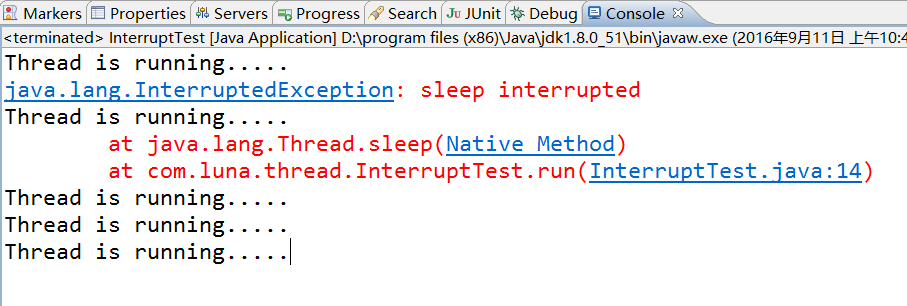一、java中终止线程主要有三种方法:
①线程正常退出,即run()方法执行完毕了
②使用Thread类中的stop()(已过期不推荐使用)方法强行终止线程。
③使用中断机制
t.stop()调用时,终止线程,会导致该线程所持有的锁被强制释放,从而被其他线程所持有,因此有可能导致与预期结果不一致。下面使用中断信号量中断非阻塞状态的线程中:
public class TestStopThread {
public static void main(String[] args) throws InterruptedException {
StopThread st = new StopThread();
st.setName("线程st");
st.start();
Thread.sleep(3000);
st.stopFlag();
Thread.sleep(1000);
System.out.println(st.getState());
}
}
class StopThread extends Thread {
// 此变量必须加上volatile
private volatile boolean stop = false;
@Override
public void run() {
// 判断线程体是否运行
while (!stop) {
System.out.println("线程StopThread正在运行");
long time = System.currentTimeMillis();
/*
* 使用while循环模拟 sleep 方法,这里不要使用sleep,否则在阻塞时会抛
* InterruptedException异常而退出循环,这样while检测stop条件就不会执行,
* 失去了意义。
*/
while ((System.currentTimeMillis() - time < 1000)) {}
}
System.out.println("线程StopThread正在结束");
}
// 线程终止
public void stopFlag() {
stop = true;
}
}
二、java线程中断机制
下面看看Thread类里的三个方法:
1. public static boolean interrupted():检测当前线程是否已经中断。线程的中断状态由该方法清除。如果连续两次调用该方法,则第二次调用将返回 false(在第一次调用已清除了其中断状态之后,且第二次调用检验完中断状态前,当前线程再次中断的情况除外)。
2. public boolean isInterrupted():测试线程是否已经中断。线程的中断状态不受该方法的影响。
3. public void interrupt(): 中断线程。
interrupt()只是改变中断状态而已. interrupt()不会终止一个正在运行的线程。
public class TestInterrupt1 {
public static void main(String[] args) throws InterruptedException {
Thread t = new MyThread();
t.start();
t.interrupt();
System.out.println("调用线程的interrupt()方法");
System.out.println("线程的中断状态:" +t.isInterrupted());
}
static class MyThread extends Thread {
public void run() {
long time = System.currentTimeMillis();
System.out.println("线程正在运行");
/*
* 使用while循环模拟 sleep 方法,这里不要使用sleep,否则在阻塞时会抛
* InterruptedException异常而退出循环。
*/
while ((System.currentTimeMillis() - time < 1000)) {}
System.out.println("线程的中断状态:" + Thread.interrupted());
System.out.println("线程的中断状态被清除:" +isInterrupted());
while ((System.currentTimeMillis() - time < 5000)) {}
System.out.println("线程运行完成");
}
}
}正常输出:
调用线程的interrupt()方法
线程正在运行
线程的中断状态:true
线程的中断状态:true
线程的中断状态被清除:false
线程运行完成实际上当调用interrupt()方法的时候,只是设置了要中断线程的中断状态,而此时被中断的线程的可以通过isInterrupted()或者是Thread.interrupted()方法判断当前线程的中断状态是否标志为中断。
调用线程的wait(), wait(long)或wait(long, int)会让它进入等待(阻塞)状态,或者调用线程的join(), join(long), join(long, int), sleep(long), sleep(long, int)也会让它进入阻塞状态。若线程在阻塞状态时,调用了它的interrupt()方法,那么它的“中断状态”会被清除并且会收到一个InterruptedException异常。例如,线程通过wait()进入阻塞状态,此时通过interrupt()中断该线程;调用interrupt()会立即将线程的中断标记设为“true”,但是由于线程处于阻塞状态,所以该“中断标记”会立即被清除为“false”,同时,会产生一个InterruptedException的异常。
public class InterruptTest extends Thread{
public static void main(String[] args) throws InterruptedException {
InterruptTest t=new InterruptTest();
t.start();
Thread.sleep(1000);
t.interrupt();
}
public void run(){
while(!Thread.interrupted()){
System.out.println("Thread is running.....");
try {
Thread.sleep(5000);
} catch (InterruptedException e) {
// TODO Auto-generated catch block
e.printStackTrace();
}
}
}
}正常运行结果:

上面只是一种情况,如果线程被调用了interrupt(),那么如果此次该线程并不在wait(),sleep(),join()时,下次执行wait(),sleep(),join()时,一样会抛出InterruptedException,当然抛出后该线程的中断状态也回被系统复位。我们可以手动的使用Thread.interrupted()来使当前线程的中断状态系统复位(即清除中断状态),其实是在sleep,wait,join这些方法内部会不断检查中断状态的值,而自己抛出的InterruptedException。
下面看中断的源码:
/**
* Interrupts this thread.
*
* <p> Unless the current thread is interrupting itself, which is
* always permitted, the {@link #checkAccess() checkAccess} method
* of this thread is invoked, which may cause a {@link
* SecurityException} to be thrown.
*
* <p> If this thread is blocked in an invocation of the {@link
* Object#wait() wait()}, {@link Object#wait(long) wait(long)}, or {@link
* Object#wait(long, int) wait(long, int)} methods of the {@link Object}
* class, or of the {@link #join()}, {@link #join(long)}, {@link
* #join(long, int)}, {@link #sleep(long)}, or {@link #sleep(long, int)},
* methods of this class, then its interrupt status will be cleared and it
* will receive an {@link InterruptedException}.
*
* <p> If this thread is blocked in an I/O operation upon an {@link
* java.nio.channels.InterruptibleChannel InterruptibleChannel}
* then the channel will be closed, the thread's interrupt
* status will be set, and the thread will receive a {@link
* java.nio.channels.ClosedByInterruptException}.
*
* <p> If this thread is blocked in a {@link java.nio.channels.Selector}
* then the thread's interrupt status will be set and it will return
* immediately from the selection operation, possibly with a non-zero
* value, just as if the selector's {@link
* java.nio.channels.Selector#wakeup wakeup} method were invoked.
*
* <p> If none of the previous conditions hold then this thread's interrupt
* status will be set. </p>
*
* <p> Interrupting a thread that is not alive need not have any effect.
*
* @throws SecurityException
* if the current thread cannot modify this thread
*
* @revised 6.0
* @spec JSR-51
*/
public void interrupt() {
if (this != Thread.currentThread())
checkAccess();
synchronized (blockerLock) {
Interruptible b = blocker;
if (b != null) {
interrupt0(); // Just to set the interrupt flag
b.interrupt(this);
return;
}
}
interrupt0();
}
/**
* Tests whether the current thread has been interrupted. The
* <i>interrupted status</i> of the thread is cleared by this method. In
* other words, if this method were to be called twice in succession, the
* second call would return false (unless the current thread were
* interrupted again, after the first call had cleared its interrupted
* status and before the second call had examined it).
*
* <p>A thread interruption ignored because a thread was not alive
* at the time of the interrupt will be reflected by this method
* returning false.
*
* @return <code>true</code> if the current thread has been interrupted;
* <code>false</code> otherwise.
* @see #isInterrupted()
* @revised 6.0
*/
public static boolean interrupted() {
return currentThread().isInterrupted(true);
}
/**
* Tests whether this thread has been interrupted. The <i>interrupted
* status</i> of the thread is unaffected by this method.
*
* <p>A thread interruption ignored because a thread was not alive
* at the time of the interrupt will be reflected by this method
* returning false.
*
* @return <code>true</code> if this thread has been interrupted;
* <code>false</code> otherwise.
* @see #interrupted()
* @revised 6.0
*/
public boolean isInterrupted() {
return isInterrupted(false);
}
/**
* Tests if some Thread has been interrupted. The interrupted state
* is reset or not based on the value of ClearInterrupted that is
* passed.
*/
private native boolean isInterrupted(boolean ClearInterrupted);中断:如果线程在调用Object类的wait()、wait(long)或wait(long, int)方法,或者该类的 join() 、join(long) 、join(long, int) 、sleep(long) 或 sleep(long, int) 方法过程中受阻,则其中断状态将被清除,它还将收到一个 InterruptedException。
如果该线程在可中断的通道(java.nio.channels.InterruptibleChannel)上的 I/O 操作中受阻,则该通道将被关闭,该线程的中断状态将被设置并且该线程将收到一个 ClosedByInterruptException。
如果该线程在一个 Selector (java.nio.channels.Selector) 中受阻,则该线程的中断状态将被设置,它将立即从选择操作返回,并可能带有一个非零值,就好像调用了选择器的 wakeup 方法一样。
如果以前的条件都没有保存,则该线程的中断状态将被设置。
中断一个不处于活动状态的线程不需要任何作用。
检测中断:如何检测中断决定于线程所做的事情。
如果线程调用可以抛出InterruptException的方法,则捕获InterruptException,然后在catch块中处理(通常是退出run方法以中断线程)
如果调用其它方法,则可以在空闲时检查Thread.interrupted以判断是否收到中断信号,确认收到中断信号后进行处理。可以抛出一个InterruptException从而和前一种处理方法保持一致
中断状态:线程的中断机制是使用中断状态这一内部标志实现的。中断状态在调用线程的interrupt()方法时被设置(参考上面的interrupt方法说明)。
可以发现,isInterrupted被声明为native方法,取决于JVM底层的实现。调用线程的interrupt方法,并不能立即引发中断,只是设置了JVM内部的中断标记。因此,通过检查中断标记,应用程序可以做一些特殊操作,也可以完全忽略中断。
实际上Thread.interrupt()方法实际上通过某种方式通知线程,并不会直接中止该线程。具体做什么事情由写代码的人决定,通常我们会中止该线程。
三、一些不会抛出 InterruptedException 的线程阻塞操作
对于某些线程阻塞操作,JVM并不会自动抛出InterruptedException异常。例如,某些I/O操作和内部锁操作。对于这类操作,可以用其他方式模拟中断:
1)java.io中的异步socket I/O
读写socket的时候,InputStream和OutputStream的read和write方法会阻塞等待,但不会响应java中断。不过,调用Socket的close方法后,被阻塞线程会抛出SocketException异常。
2)利用Selector实现的异步I/O
如果线程被阻塞于Selector.select(在java.nio.channels中),调用wakeup方法会引起ClosedSelectorException异常。
3)锁获取
如果线程在等待获取一个内部锁,我们将无法中断它。但是,利用Lock类的lockInterruptibly方法,我们可以在等待锁的同时,提供中断能力。
参考资料:
Thread的中断机制(interrupt)
[改善Java代码]不使用stop方法停止线程
JAVA线程的interrupt
Java中断的本质与分析






















 487
487

 被折叠的 条评论
为什么被折叠?
被折叠的 条评论
为什么被折叠?








